
Concept explainers
10 minutes per unit. Part 2 is simultaneously processed at work-station C for 20 minutes per unit. Work stations B and C feed the parts to an assembler at workstation D. w here the two parts are assembled. The time at workstation D is 15 minutes.
a) What is the bottleneck of this process?
b) What is the hourly capacity of the process?
•• S7.15 A production process at Kenneth Day Manufacturing is shown in Figure S7.9. The drilling operation occurs separately from, and simultaneously with, sawing and sanding, which are independent and sequential operations. A product needs to go through only one of the three assembly operations (the operations are in parallel).
a) Which operation is the bottleneck?
b) What is the bottleneck time?
c) What is the throughput time of the overall system?
d) If the firm operates 8 hours per day. 20 days per month, what is the monthly capacity of the manufacturing process?
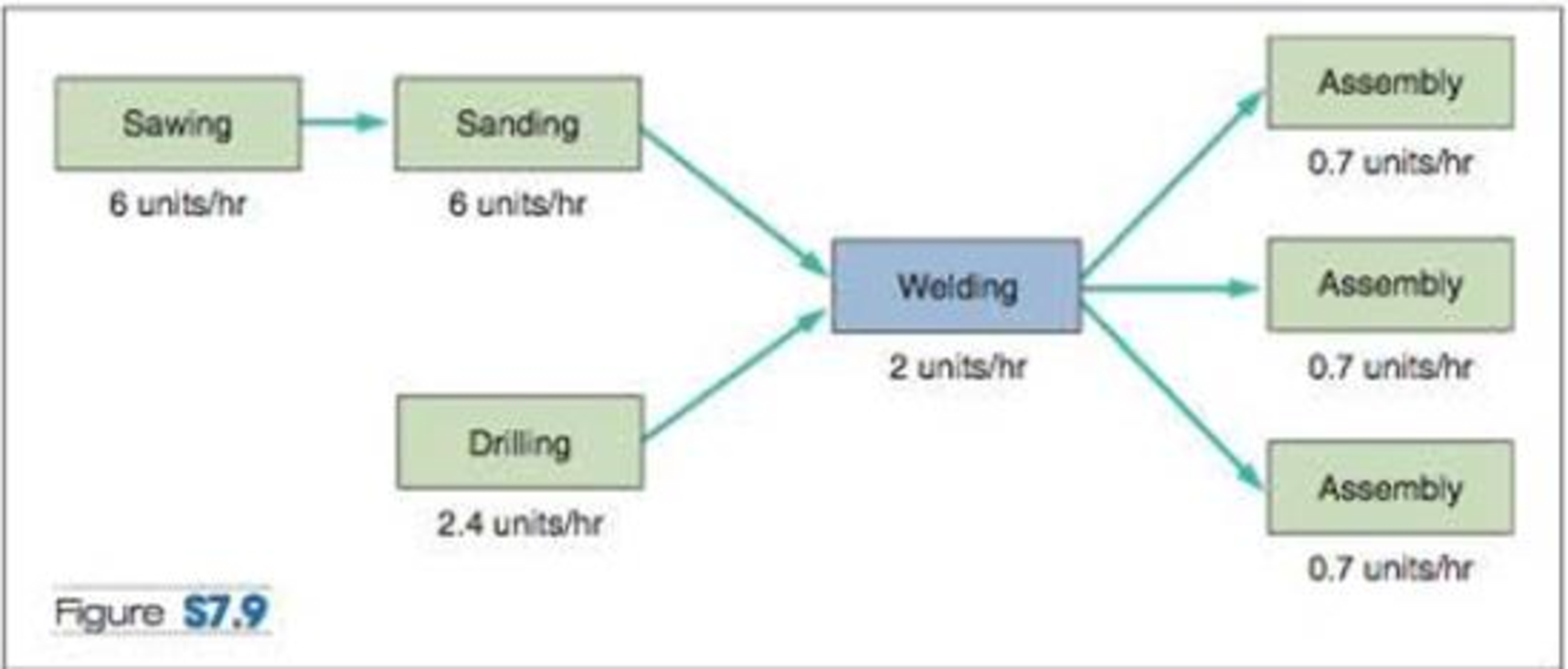
a)
To determine: The bottleneck operation.
Introduction:
Bottleneck time:
The bottleneck time of the system is the process in the system which takes the most amount of time to complete its activity. The bottleneck time will reduce the overall efficiency of the system.
Answer to Problem 15P
The bottleneck operation is Welding.
Explanation of Solution
Given information:
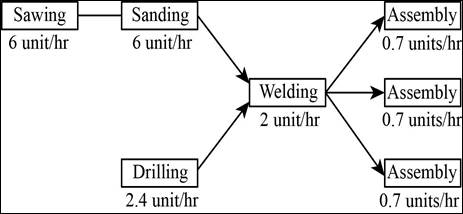
Formula to convert capacity into process time:
Formula to calculate overall assembly operation process time:
Calculation of process time for each operation:
The process time of each station is calculated by dividing the number of minutes with the production capacity of the station.
Sawing:
Sanding:
Drilling:
Sawing:
Welding:
Assembly at one operation:
Calculation of overall assembly operation process time:
The overall assembly operation process time is calculated by dividing the process time at one assembly operation by the Number of assembly operations.
Identification of the bottleneck time of the system:
The bottleneck time of the system is the operation which has the highest process time. Welding has the highest process time when compared to the other operations (30>10, 10, 25, 10, 28.57). Hence, the bottleneck time of the system is 30 minutes per unit.
Therefore, the bottleneck operation is Welding.
b)
To determine: The bottleneck time of the bottleneck operation.
Introduction:
Bottleneck time:
The bottleneck time of the system is the process in the system which takes the most amount of time to complete its activity. The bottleneck time will reduce the overall efficiency of the system.
Answer to Problem 15P
The bottleneck time of the bottleneck operation is 30.
Explanation of Solution
Given information:
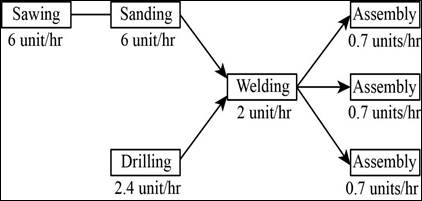
Formula to convert capacity into process time:
Formula to calculate overall assembly operation process time:
Calculation of process time for each operation:
The process time of each station is calculated by dividing the number of minutes with the production capacity of the station.
Sawing:
Sanding:
Drilling:
Sawing:
Welding:
Assembly at one operation:
Calculation of overall assembly operation process time:
The overall assembly operation process time is calculated by dividing the process time at one assembly operation by the number of assembly operations.
Identification of the bottleneck time of the system:
The bottleneck time of the system is the operation which has the highest process time. Welding has the highest process time when compared to the other operations (30 > 10, 10, 25, 10, 28.57). The bottleneck operation is Welding.
Hence, the bottleneck time of the bottleneck operation is 30 minutes per unit.
c)
To determine: The throughput time of the time of the overall system.
Introduction:
Throughput time:
The throughput time of a system is the time taken for a product to pass from the raw materials stage to the finished goods stage. The higher the throughput time the more efficient the system will be.
Answer to Problem 15P
The throughput time of the overall system is 140.71 minutes.
Explanation of Solution
Given information:
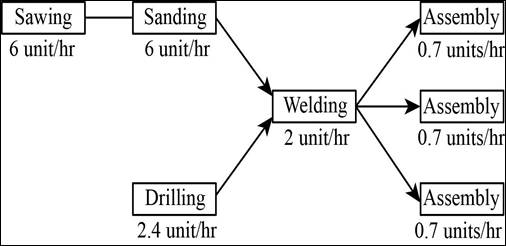
Formula to convert capacity into process time:
Formula to calculate throughput time:
Calculation of process time for each operation:
The process time of each station is calculated by dividing the number of minutes with the production capacity of the station.
Sawing:
Sanding:
Drilling:
Sawing:
Welding:
Assembly at one operation:
Calculation of throughput time:
The throughput time is calculated by identifying the maximum value of the summation of process times of Sanding, Sawing, Welding, assembly and the summation of process times of Drilling, Welding, and Assembly.
Hence, the throughput time of the overall system is 140.71 minutes.
d)
To determine: The monthly capacity of the manufacturing process.
Introduction:
Bottleneck time:
The bottleneck time of the system is the process in the system which takes the most amount of time to complete its activity. The bottleneck time will reduce the overall efficiency of the system.
Monthly capacity:
The monthly capacity is the number of units the firm is able to produce in a month’s time. It will be calculated taking into consideration of the resources and constraints present in the manufacturing process.
Answer to Problem 15P
The monthly capacity of the manufacturing process is 320 units per month.
Explanation of Solution
Given information:
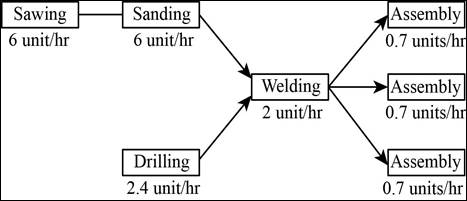
Operating time = 60 minutes / 8 hour / day
Number of days = 20 / month
Formula to convert capacity into process time:
Formula to calculate overall assembly operation process time:
Formula to calculate monthly capacity:
Calculation of process time for each operation:
The process time of each station is calculated by dividing the number of minutes with the production capacity of the station.
Sawing:
Sanding:
Drilling:
Sawing:
Welding:
Assembly at one operation:
Calculation of overall assembly operation process time:
The overall assembly operation process time is calculated by dividing the process time at one assembly operation by the Number of assembly operations.
Identification of the bottleneck time of the system:
The bottleneck time of the system is the operation which has the highest process time. Welding has the highest process time when compared to the other operations (30 > 10, 10, 25, 10, 28.57). Hence, the bottleneck time of the system is 30 minutes per unit.
Calculation of monthly capacity:
The monthly capacity is calculated by multiplying the operating time per day with the number of days per month and dividing the resultant value with the bottleneck time of the system.
Hence, the monthly capacity of the manufacturing process is 320 units per month.
Want to see more full solutions like this?
Chapter 7 Solutions
PRIN.OF OPERATIONS MANAGEMENT-MYOMLAB
- Emotional intelligence is defined as the ability to understand and manage your emotions, as well as recognize and influence the emotions of those around you. True Falsearrow_forwardAt the Ford automobile Highland plant, assume the one-millionth vehicle was produced in 1916 at a cost of $8084 (in 2013 US$), by how much did the Ford company reduce his cost with each doubling of cumulative output from 1916 to 1927?arrow_forwardAt the Ford automobile Highland plant,in 1913, how long did the average worker stay with the plant and what was the average tenure of a worker?arrow_forward
- Community Federal Bank in Dothan, Alabama, recently increased its fees to customers who use employees as tellers. Management is interested in whether its new tee policy has increased the number of customers now using its automatic teller machines to that point that more machines are required. The following table provides the number of automatic teller transactions by week. Use trend projection with regression to forecast usage for weeks 13-16.arrow_forwardDavison Electronics manufactures three LED television monitors, identified as Model A, Model B, and Model C. Davison Electronics four manufacturing plants. Each model has its lowest possible production cost when produced at Plant 1. However, Plant 1 does not have the capacity to handle the total production of all three models. As a result, at least some of the production must be routed to the other manufacturing plants. The following table shows the minimum production requirements for next month, the plant capacities in units per month, and the production cost per unit at each plant: Model Production Cost per Unit Minimum Production Requirements Plant 1 Plant 2 Plant 3 Plant 4 A $25 $28 $37 $34 48,000 B $26 $35 $36 $41 75,000 C $20 $31 $26 $23 60,000 Production Capacity 65,000 50,000 32,000 43,000 Davison’s objective is to determine the cost-minimizing production planarrow_forwardAnecdotally, entrepreneurs frequently encounter two critical dilemmas in managing human resources: the timing of hiring and the decision regarding hiring a generalist versus a specialist for their growing venture. Deciding when to expand a team is crucial, as premature hiring (i.e., hiring too soon) can strain resources, while delayed hiring (i.e., hiring too late) might hinder growth opportunities. Moreover, the choice between hiring a generalist or a specialist depends on the specific needs and stage of the venture, with each option presenting distinct advantages and challenges. To address these issues, a management scholar seeks to identify the factors shaping the hiring cycle throughout the entrepreneurial journey and to understand the criteria for choosing between generalists and specialists at various stages of a venture. The scholar has assembled a sample of 20 experienced South African entrepreneurs who have encountered both failure and success in the financial technology…arrow_forward
- 3. [25 pts.] Four projects are available for investment. The projects require the cash flows and yield the net present values (NPV) (in millions) shown in the following table. Project id. 1 2 Cash outflow at time 0 (million Lira) 8 8 NPV (million Lira) 12 11 3 4 6 5 8 6 If 20 million Lira is available for investment at time 0, find the investment plan that maximizes NPV. All investments are required to be 0 or 1 (fractional investment values are not permitted). a. Formulate the mathematical model. (Write the decision variables, objective function and the constraints.) [10 pts.] b. Find the optimal solution by using Branch and Bound method (Draw the branch and bound tree clearly, write also lower bounds(LB)) (Left branches x=0, right branches x =1) [15 pts.].arrow_forwardexamine the production concept and operations management, what are the key steps required to achieve success? Be specific in your response.arrow_forwardProduce a 3000 report with references on one international organization of your choice and Address the following: Provide a brief introduction of the organisation and sector it operates in, including its mission and vision statements, its core values, a summary of its financial performance and a general overview of the business’s operational activities. From the relevant literature explain the Total Quality Management (TQM) processes the chosen organization follows and identify one quality challenge/issue that the organization faced or is currently facing. Explain how the organization managed/or still managing the particular quality challenge/issue. Critically analyze whether the organization failed or succeeded in achieving and maintaining quality performance. Provide a few critical recommendations for business managers in order to highlight the importance of Total Quality Management (TQM) within an organization.arrow_forward
- 問題2 Production system design involves determining the arrangement of workstations and the... O allocation of resources to workstations design of the process O production schedule all of the abovearrow_forwardElaborate on the need for and the benefits of an effective supply chain management (SCM) system in the context of a globalized and networked economy. In your answer, explain how organizations like Dell and Hewlett-Packard leverage supply chain networks to maintain competitiveness, and analyse the impact of globalization, technological advancements, and business environment changes on supply chain structures. Additionally, evaluate the key components of SCM, including distribution network configuration, inventory management, and cash-flow management, and discuss how these components contribute to creating an effective and integrated supply chain. (15) 3.2. Critically evaluate the requirements for effective inventory management within an organization. In your answer, discuss the importance of inventory accounting systems, the role of cost information (holding, ordering, and shortage costs), and the significance of classification systems like ABC analysis. Additionally, analyse how…arrow_forwardAssess the role of EDI in ensuring supply chain security and data integrity. How does EDI contribute to reducing vulnerabilities in supply chain operations, and what best practices should organizations adopt to maintain a secure and reliable EDI system? (10) 1.3. Examine how the adoption of modern EDI systems influences the strategic decision-making process in supply chain management. How does EDI provide supply chain managers with actionable insights, and what are the implications of these insights for long-term supply chain planning? (10) 1.4. Evaluate the potential challenges and risks associated with the modernization of EDI systems in supply chain management. How can organizations effectively manage these challenges to ensure successful EDI implementation and ongoing optimization? (10)arrow_forward
 Practical Management ScienceOperations ManagementISBN:9781337406659Author:WINSTON, Wayne L.Publisher:Cengage,MarketingMarketingISBN:9780357033791Author:Pride, William MPublisher:South Western Educational Publishing
Practical Management ScienceOperations ManagementISBN:9781337406659Author:WINSTON, Wayne L.Publisher:Cengage,MarketingMarketingISBN:9780357033791Author:Pride, William MPublisher:South Western Educational Publishing Purchasing and Supply Chain ManagementOperations ManagementISBN:9781285869681Author:Robert M. Monczka, Robert B. Handfield, Larry C. Giunipero, James L. PattersonPublisher:Cengage Learning
Purchasing and Supply Chain ManagementOperations ManagementISBN:9781285869681Author:Robert M. Monczka, Robert B. Handfield, Larry C. Giunipero, James L. PattersonPublisher:Cengage Learning




